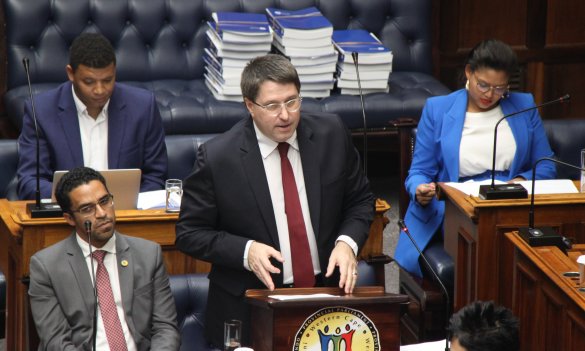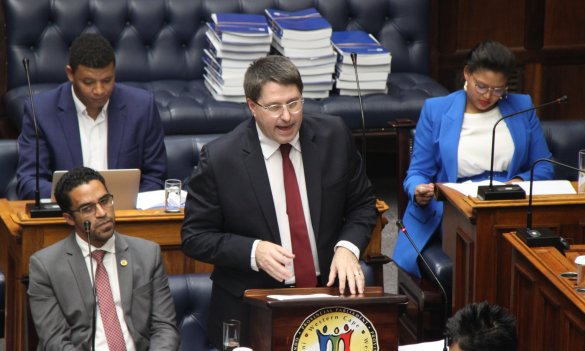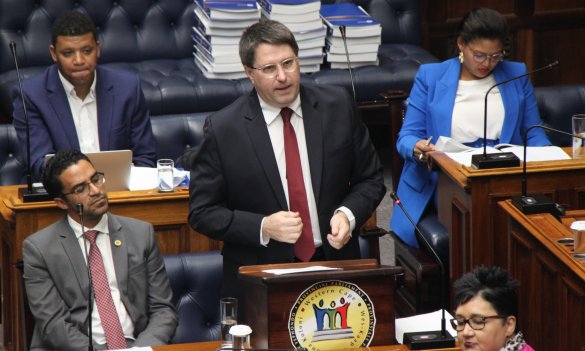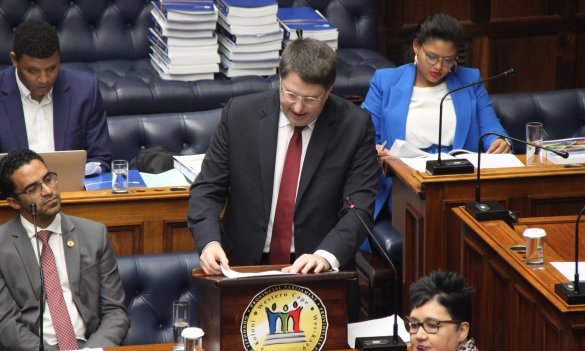Provincial and Municipal Economic Review & Outlook 2019
Honourable Speaker;
Honourable Premier and Cabinet Colleagues;
Honourable Leader of the Opposition; and
Honourable Members of the Western Cape Provincial Parliament.
- Introduction
I would like to begin by thanking you for the opportunity to introduce the Provincial Economic Review & Outlook 2019, together with the Municipal Economic Review & Outlook 2019, today in the Western Cape Provincial Parliament.
The Provincial Economic Review & Outlook 2019 and its rather more thick-set “twin”, the Municipal Economic Review & Outlook 2019 are world-class research publications produced by Provincial Treasury.
The “twins” contain forecasts of future trends, analysis of past trends, and serve as a “one stop research shop” to support the policy, planning and budgeting process at provincial and municipal level in the Western Cape.
The Provincial Economic Review & Outlook 2019 and the Municipal Economic Review & Outlook 2019 are filled with fascinating numbers about the Western Cape.
To whet your appetite:
- there are 801 hectares planted with guavas;
- there are 780 hectares planted with pomegranates; and
- there are 143 hectares planted with prickly pears in the Western Cape.
The Provincial Economic Review & Outlook 2019 and the Municipal Economic Review & Outlook 2019 are also filled with fascinating facts about the Western Cape.
To whet your appetite:
- our top export market is Namibia; our top import market is Saudi Arabia; our fastest growing export market is China; and our fastest growing import market is Ghana;
- we export blueberries; we export blackberries; and we export raspberries;
- we export locust beans; we export seaweed; we export algae; and we export molluscs; and
- most fascinating of all, we export what is referred to as “other aquatic invertebrates”, which intriguingly does not include molluscs.
- Review
However, on a serious note, the Provincial Economic Review & Outlook 2019 and the Municipal Economic Review & Outlook 2019 tell a story that is not always what we want to hear, but that we must hear, and which we must confront, in the Western Cape.
2.1 Slow recovery in economic growth in the Western Cape
On the economic outlook:
We expect:
- a slow recovery in economic growth in the Western Cape.
We expect:
- global economic growth to slow down to 3.2% in 2019 and recover to 3.5% in 2020.
We expect:
- national economic growth to slow down to 0.2% in 2019 and recover to 1.1% in 2020.
And we expect:
- provincial economic growth to recover to 0.7% in 2019 and accelerate to 1.2% in 2020.
Which means:
- that the provincial economy is expected to recover from the drought and the contraction in output from the agriculture, forestry and fisheries sector; and
- that the provincial economy is expected to grow at a faster rate than the national economy in South Africa.
2.2 Private services to drive economic growth in the Western Cape
On economic sectors:
We expect:
- private services to drive economic growth in the Western Cape.
We expect:
- private services – which include wholesale and retail trade; catering and accommodation; transport, storage and communication; finance, insurance, real estate and business services; as well as community, social and personal services – to be the biggest driver of economic growth, fixed investment and employment in the Western Cape.
And we expect:
- agriculture and agri-processing to be the fastest growing sectors as they recover from the contraction caused by the drought in the Western Cape.
Overall, we expect:
- the provincial economy to expand by an average of 1.6% over the next five years between 2019 and 2023.
2.3 Rebound in employment in the Western Cape
On the labour market:
2.3.1 Participation
We have:
- a higher than average labour force participation rate of 66.5% in the Western Cape.
Which means:
- that 66.5% of the working-age population are part of the labour force in the Western Cape.
2.3.2 Employment
We have:
- a total of 2.5 million people employed compared to 2.2 million people five years ago in the Western Cape.
The fact is:
- employment increased by 283 000, or at an average annual growth rate of 2.4% per year, in the Western Cape, which is higher than the national average annual growth rate of 1.6% per year in the five years between 2014 [Q1] and 2019 [Q1] in South Africa.
However, in the end, there are too few people who have jobs in the Western Cape.
2.3.3 Unemployment
We have:
- the lowest “narrow unemployment rate” at 19.5% in the Western Cape, compared to Gauteng, which has a narrow unemployment rate of 28.9%, and KwaZulu-Natal, which has a narrow unemployment rate of 25.1%.
We have:
- the lowest “expanded unemployment rate” at 22.7% in the Western Cape, compared to Gauteng, which has an expanded unemployment rate of 33.6%, and KwaZulu-Natal, which has an expanded unemployment rate of 42.4%.
Which means:
- unemployment increased by 18 000, or at an average annual growth rate of 0.6% per year, in the Western Cape, which is lower than the national annual growth rate of 4.1% per year in the five years between 2014 [Q1] and 2019 [Q1] in South Africa.However, in the end, there are too many people who do not have jobs in the Western Cape.
2.4 Steadily Improving human development
On development:
We have:
- a population of 6.8 million, or 11.4% of the total population in South Africa.
We have:
- increasing income inequality but an improving Human Development Index.
The Human Development Index, which is a composite indicator of population development, and which measures inter alia education, life expectancy and per capita income, has improved steadily from 0.682 in 2009 to 0.730 in 2019, which could be the result of effective support to people, especially poor people, by government in the Western Cape.
Generally:
- there has been an improvement in education outcomes, with a 15.8% increase in the number of learners accessing education in the past six years here in the Western Cape.
- there has been an improvement in health outcomes, with consistent improvements in HIV testing and anti-retroviral therapy initiation rates, so that more people know their status, and more people receive treatment here in the Western Cape; and
- there has been an improvement in the provision of basic services, with households having the highest rate of access to tap water in the country here in the Western Cape.
However, although overall crime has decreased, the murder rate has increased significantly and the leading cause of premature death among males is interpersonal violence in the Western Cape.
- Risk
The Provincial Economic Review & Outlook 2019 and the Municipal Economic Review & Outlook 2019 tell us a story:
- of a slow recovery in economic growth, driven by private services in the Western Cape;
- of a rebound in employment in the Western Cape; and
- of improved human development in the Western Cape.
The Provincial Economic Review & Outlook 2019 and the Municipal Economic Review & Outlook 2019 also tell us a story:
- of new and exciting opportunities in the economy in the Western Cape.
Consider:
- to the strides made developing alternative crops, which are labour intensive and have export potential, and the strides made developing the halal export market in the Western Cape.
However, the fact is:
- that although the provincial economy is expected to grow at an average of 1.6% over the next five years, this is slower than the average growth of 1.7% in the five years between 2008 and 2017, which included a meltdown of the global economy;
- that although the provincial business confidence index is higher than the national business confidence index, the national business confidence index has collapsed and is at a twenty-year low; and
- that although the provincial economy increased employment at a faster annual average growth rate than the national economy, there are still too many people who do not have jobs, or who have given up looking for jobs, in the Western Cape.
The downside risks to the provincial economy are considerable and include slowing global economic growth as a result of trade wars, and political developments, such as a possible “no deal” Brexit.
However, the fact remains that the biggest risk to the provincial economic outlook is not slowing global growth, trade wars or a “no deal” Brexit.
The fact is that the national economy, and the provincial economy, are linked and for that reason the biggest risk to the provincial economic outlook is national government in South Africa.
We have:
- equivocation, prevarication and dithering, combined with summits, dialogues and conferences, rather than decisive leadership on the economy in South Africa.
We have:
- destructive wasp-in-the-jar-like infighting inside the governing party over economic policy in South Africa.
We have:
- stagnant national economic growth, with the economy forecast to grow at an average of about 1.3% over the medium term in South Africa.
We have:
- collapsing business confidence, which is at an all-time twenty-year low in South Africa.
We have:
- declining per capita incomes, as the population growth rate exceeds the economic growth rate, which means the poor are getting poorer in South Africa.
We have:
- staggering levels of unemployment, with nearly 10 million people who do not have jobs, or who have given up looking for jobs, in South Arica.
We have:
- eyewatering levels of national debt, with national debt that will now exceed an estimated R3.4 trillion, or 59% of GDP, in 2021/22 in South Africa.
We have:
- zombie national departments, like the Department of Home Affairs, who seem determined to keep foreign investors and highly skilled immigrants out of South Africa.
We have:
- zombie state-owned enterprises, like the Passenger Rail Agency, South African Airways, Transnet Freight Rail and the Transnet Port Authority, delivering shocking services, at uncompetitive prices, and consuming billions of Rands in bailouts in South Africa.
We have:
- massive fiscal risks, including most importantly Eskom, which has a debt mountain of about R440 billion, costing a staggering R67 billion in debt service costs, which could “blow up” the national balance sheet in South Africa.
We have:
- sovereign credit ratings agencies, like Moody’s Investor Services, circling us like sharks, ready to downgrade our sovereign credit rating to “junk status” in South Africa.
- Response
We all remember the sense of renewal, of revitalization and of progress following President Cyril Ramaphosa’s first State of the Nation Address on 16 February 2018, and we all remember the announcement of a “new path” of economic growth, of employment and of transformation in South Africa.
However, that sense of renewal, of revitalization and of progress, along with the “new path” of economic growth, of employment and of transformation, is over in South Africa.
The veneer of President Cyril Ramaphosa as the “master negotiator”, who plays the long game and who has everything under control, has been shattered in South Africa.
When faced with tough decisions, President Cyril Ramaphosa is inclined to negotiate, prevaricate and equivocate, by calling summits, conferences and dialogues in South Africa.
The fact is that, rather than clear and decisive leadership, there is a sense of paralysis because, in the end, President Cyril Ramaphosa will not decide, because he is too scared to divide the ANC/SACP/Cosatu alliance in South Africa.
Which has resulted in a descent into economic madness, with national government considering reckless economic policy proposals, including land expropriation without compensation, state-owned banks, prescribed assets and the nationalization of the reserve bank, in South Africa.
- Conclusion
We have worked hard to create an enabling environment for the private sector and for the markets, to drive economic growth and job creation in the Western Cape.
We cannot, and we will not, sit back and allow national government to become a ball-and-chain holding back the economy in the Western Cape.
The fact is that Premier Alan Winde has set out a bold vision, and is implementing that bold vision, here in the Western Cape.
The Premier has:
- announced the most comprehensive and expensive safety plan in the history of the Western Cape.
The safety plan includes both a law enforcement component and a violence prevention component with 3 000 new law enforcement officers doing visible policing; 150 investigators working up dockets for prosecution; and will provide support to 10 000 children and their caregivers during the first 1 000 days of the child’s life in the Western Cape.
The Premier has:
- announced the establishment of an “Economic War Room” to promote economic growth in the Western Cape.
The Economic War Room pilot project has commenced, with teams from the province, from the city and from the private sector working together on eliminating obstacles to economic growth in the construction, manufacturing and business services sector in the Western Cape.
Which, of course, does not include many of this government’s existing programmes to drive economic growth and jobs creation, including red-tape reduction, air access, and investment and export promotion in the Western Cape.
We will work hard to ensure:
- that the provincial economy grows at a faster rate than the national economy;
- that provincial business confidence is greater than national business confidence; and
- that provincial employment grows at a faster rate than the national economy in the Western Cape.
And we will do it so that more people, especially young people, have jobs, and live with dignity, with independence and with hope in the Western Cape.
- Tabling
Speaker:
I hereby table the Provincial Economic Review & Outlook 2019 and the Municipal Economic Review & Outlook 2019 for consideration and deliberation in the Western Cape Parliament.
I can assure Honourable Members that the Provincial Economic Review & Outlook 2019 and the Municipal Economic Review & Outlook 2019 are world-class research documents that will assist them in their duties in the Western Cape Provincial Parliament.
And finally:
I would like to thank everybody who made contributions and who worked so hard to produce the Provincial Economic Review & Outlook 2019 and the Municipal Economic Review & Outlook 2019.
“We expect a recovery in the economy in the Western Cape”
Click the link below to download the documents





